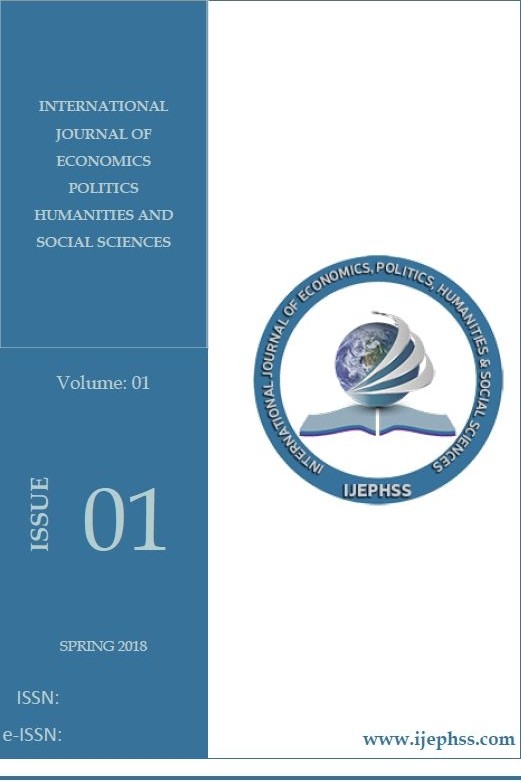GEÇİŞ EKONOMİLERİNDE EKONOMİK VE TOPLUMSAL DÖNÜŞÜM: YUGOSLAVYA ÖRNEĞİ
Yugoslavya, geçiş ekonomisi, sosyalist özyönetim sistemi, Josip Broz Tito, Yugoslavia, transition economy, socialist self-management system
ECONOMIC AND SOCIAL TRANSFORMATION IN TRANSITIONAL ECONOMIES: THE CASE OF YUGOSLAVIA
___
- Arhiv Jugoslaviye. (t.y.). The Constitution of The Socialist Federative Republic Of Yugoslavia (1963), 10.11.2022,www.arhivyu.gov.rs/active/en/home/glavna_navigacija/leksikon_jugoslavije/konstitutivni_akti_jugoslavije/ustav_sfrj_1963.html#
- Arman, M. N. (2007). “Avrupa Birliğinin Batı Balkanlar Genişlemesi: Bir Dış Politika Aracı Olarak Kimlik Dönüşümü”, Doktora Tezi, Dokuz Eylül Üniversitesi/Sosyal Bilimler Enstitüsü, İzmir.
- Ay, İ. C., & Turgan, E. (2015). European Union’s Fiscal Aids and Its Effects on Member and Non-Member Countries: Turkey Case. İstanbul Gelişim Üniversitesi Sosyal Bilimler Dergisi, 2(1), 161-176.
- Ayhan, H. (2008). Kosova’nın Bağımsızlığı Sürecinde Uluslararası Güçlerin ve Türkiye’nin Tutumu. Avrasya Etüdleri, 33(1), 113-134.
- Bora, T. (2018). Milliyetçiliğin Provokasyonu Yugoslavya. İletişim Yayınları, İstanbul.
- Brown, M. B. (1997). The Role of Economic Factors in Social Crisis: The Case of Yugoslavia. New Political Economy, 2(2), 299-315.
- Corker, R. J., Rehm, D. E., & Kostial, K. (2001). Kosovo: Macroeconomic Issues and Fiscal Sustainability. In Kosovo. International Monetary Fund.
- Eyidiker, U. (2020). Geçiş Ekonomisi Kavramı ve Bir Geçiş Ekonomisi Örneği Türkmenistan. Sosyal Bilimler Metinleri, 2020(1), 13-35.
- Gligorov, V. (2003). Serbia and Montenegro: Transition with Organized Crime (No. 19). The Vienna Institute for International Economic Studies, wiiw.
- Günal, A. (2012). “Sırbistan” (Ed. Nazif Mandacı, Murat Necip Arman), Çağdaş Balkan Siyaseti, ss. 85-115, Gazi Kitabevi, Ankara.
- Havrylyshyn, O. & Wolf, T. (1999). Determinants of Growth in Transition Countries. Finance & Development, 36(002).
- IMF. (1995). Press Release: Bosnia and Herzegovina Becomes a Member of the IMF; Receives IMF Credit from Emergency Window, 31.10.2022, www.imf.org/en/News/Articles/2015/09/14/01/49/pr9570
- IMF. (1997). Press Release: IMF Approves Three-Year Extended Fund Facility for Croatia, 31.10.2022, www.imf.org/en/News/Articles/2015/09/14/01/49/pr9712
- IMF. (1998). Press Release: IMF Approves Stand-by for Bosnia and Herzegovina, 31.10.2022, www.imf.org/en/News/Articles/2015/09/14/01/49/pr9819
- Katchanovski, I. (2000). Divergence in Growth in Post-Communist Countries. Journal of Public Policy, 20(1), 55-81.
- Kenar, N. (2005). Bir Dönemin Perde Arkası Yugoslavya. Palme Yayıncılık, Ankara.
- Mandacı, N. & Arman, M. N. (2012). “Güneydoğu Avrupa Değil Balkanlar” (Ed. Nazif Mandacı, Murat Necip Arman), Çağdaş Balkan Siyaseti, ss. 1-11, Gazi Kitabevi, Ankara.
- Micevska, M., Eftimoski, D., & Mircevska, T. P. (2002). Economic growth of the Republic of Macedonia: experiences and policy recommendations. World Bank Global Research Project May.
- Mrak, M., Rojec, M., & Potočnik, J. (2002). The Transition Process in Slovenia: Transformation to an EU-Compatible Economy. Journal of International Relations and Development, 5(1), 37-62.
- OECD. (2002). Federal Republic Of Yugoslavia Economic Assessment, 31.10.2022, www.oecd.org/newsroom/archives/1840294.pdf
- Sancaktar, C. (2018). Yugoslavya’da Sosyalist Özyönetim Deneyimi. Doruk Yayınları, İstanbul.
- Sancaktar, C. (2021). Yugoslavya’da Sosyalizmden Kapitalizme Geçiş. Doruk Yayınları, İstanbul.
- Serbes, H. & Tokatlıoğlu, M. (2019). Avrupa Birliği’ne Üyelik Sürecinde Türkiye Ve Batı Balkan Ülkelerinin Ekonomik Ve Mali Performansı: Küresel Kriz Sonrası Bir Değerlendirme. Journal of Life Economics, 6(2), 163-196.
- Stanbic. (2022). Foreign Direct Investment (FDI) in Montenegro, 10.11.2022, https://www.tradeclub.stanbicbank.com/portal/en/market-potential/montenegro/investment
- Stojcic, N. (2012). Two Decades of Croatian Transition: A Retrospective Analysis. South East European Journal of Economics & Business, 7(2), 63-76.
- Tandırcıoğlu, H. (2002). Geçiş Ekonomilerinde Özelleştirme. Dokuz Eylül Üniversitesi Sosyal Bilimler Enstitüsü Dergisi, 4(3), 198-226.
- Ulusoy, M. K. & Özçelik, S. E. (2020). Balkan Ülkelerinin Ekonomik ve Finansal Yapısı: Sorunlar ve Öneriler. Elektronik Sosyal Bilimler Dergisi, 19(74), 1033-1056.
- Uvalic, M. (2012). Serbia's Transition To Market Economy: Why Has The Model Not Delivered?. Montenegrin Journal of Economics, 8(2), 87.
- Uvalic, M. (2021). Economic roots of Yugoslavia’s disintegration. The Vienna Institute for International Economic Studies, Special Issue 30th Anniversary of the Break-up of Yugoslavia.
- Ülger, İ. K. (2016). Yugoslavya Neden Parçalandı?. Umuttepe Yayınları, Kocaeli.
- World Bank. (t.y.). World Bank Open Data, 10.11.2022, www.data.worldbank.org
- Başlangıç: 2018
- Yayıncı: Onur OĞUZ
GEÇİŞ ÜLKELERİNDE KAYIT DIŞI EKONOMİ VE KARAPARA KAVRAM İNCELEMESİ
Abdulkadir BİLEN, Havva BÖREKCİ ŞAHAN
GEÇİŞ EKONOMİLERİNDE EKONOMİK VE TOPLUMSAL DÖNÜŞÜM: YUGOSLAVYA ÖRNEĞİ
Özge KOBAK, Yaprak KARADAĞ DUYMAZLAR
COVİD-19 PANDEMİSİNİN AZERBAYCAN’IN MAKROEKONOMİK GÖSTERGELERİNE ETKİSİ
GEÇİŞ EKONOMİLERİNDE EKONOMİK KARMAŞIKLIK VE EKONOMİK BÜYÜME İLİŞKİSİ: ÇEK CUMHURİYETİ ÖRNEĞİ
GÜRCİSTAN'DA İNTERNET KULLANIMI VE YAŞAM DOYUMU
ÖZBEKİSTAN’IN DÖNÜŞÜM SÜRECİNDE MAKRO EKONOMİK VE FİNANSAL GELİŞMELER
